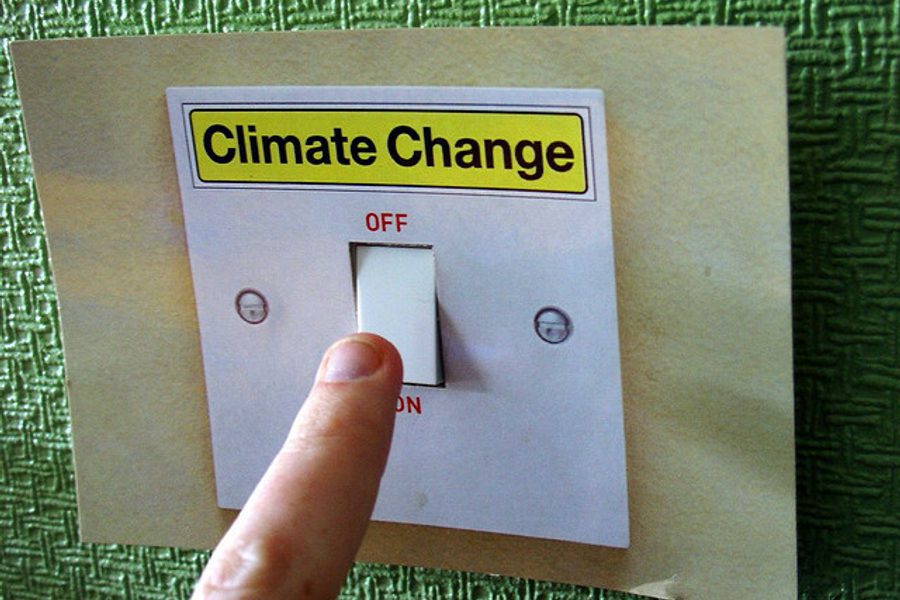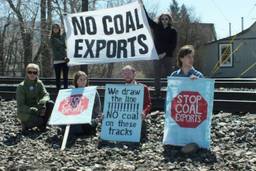The People’s Climate March: This Generation’s March on Washington?
The climate justice movement is preparing for what could be its biggest mobilization yet. The stakes couldn’t be higher.
Nick Engelfried

On August 28, 1963, 200,000 people swarmed into the nation’s capital for one of the most iconic moments in the civil rights movement: the March on Washington for Jobs and Freedom. More often remembered today simply as the March on Washington, it was seen by many as a turning point for the civil rights movement, which helped spur passage of the 1964 Civil Rights Act and 1965 Voting Rights Act.
Today, with hundreds of thousands of people preparing to descend on one of the country’s largest cities for the September 21 People’s Climate March, some are hoping for a similarly transformative moment in the climate movement. But whether the People’s Climate March succeeds in generating the kind of results achieved by the 1963 March on Washington — and whether that is, in fact, a desirable outcome — remains to be seen.
Back in 2009, writing for Orion magazine, Bill McKibben said, “Instead of another march on Washington or London, we’re collecting images from every corner of the world.” He was referring to the recently founded organization 350.org and the preparations for its first international day of action on climate change. In October of that year, people in almost every country staged more than 5,000 actions calling attention to 350 ppm, the maximum safe threshold for atmospheric parts per million of carbon dioxide. They helped focus attention on the importance of getting back to 350 ppm, in the lead-up to the 2009 U.N. climate talks in Copenhagen.
The quote from McKibben suggests organizers of the 2009 mobilization envisioned a movement not dependent on big marches in national capitals — and such an approach had the advantage of being new and different. An equally important factor, though seldom or never mentioned by movement organizers, was that the 2009 climate movement, at least in the United States, simply wasn’t ready for a major march on anywhere. The largest U.S. climate gathering up to that point, Energy Action Coalition’s national Power Shift event in early 2009, had consisted of just slightly more than 10,000 people. There wasn’t going to be a climate moment like the March for Jobs and Freedom that year.
350.org’s 2009 actions ranged from groups of 20 or 30 people posing for photos in U.S. towns and cities, to slightly larger rallies of hundreds of people, to a few much bigger actions like a march of 15,000 in Addis Ababa, Ethiopia. Though none came close to rivaling the March for Jobs and Freedom, the actions did help stir debate at the Copenhagen talks. But as successive years failed to produce major national or international action on climate change, at least some groups seem to have decided a climate mobilization of hundreds of thousands — something on the scale of the March for Jobs and Freedom and other major events from past social movements — is necessary after all. Thus the decision by 350.org and other nonprofits to organize the People’s Climate March, which will take place right before a climate summit convened by U.N. Secretary General Ban Ki Moon in New York City later this month.
Not everyone in the climate movement is convinced the march will work.
“Spending millions of dollars to plan a climate march corresponding with a U.N. summit gives me flashbacks to 2009 in Copenhagen,” said Jasmine Zimmer-Stucky of Portland Rising Tide. “If this march were to occur in Utah instead of on the streets of New York City, it could actually shut down the nation’s first-ever tar sands mine. This march could happen on train tracks almost anywhere in the nation and stop a dangerous oil train from the Bakken [shale field in North Dakota]. Instead, it runs the risk of silencing these frontline struggles and overshadowing real, direct ways for people to engage in the climate movement.”
In a recent article for Counterpunch, Scott Parkin of Rising Tide North America argued that “real change won’t come from professional activists rooted in the existing political and economic system. It’ll come from a [grassroots] mobilization of people willing to engage in risk and sacrifice.”
There are already examples of people starting to risk their freedom and safety to confront fossil fuel industries at the grassroots level. On August 25, two men U-locked themselves to a truck involved in construction of a tar sands oil pipeline in Michigan, risking what they anticipated might be felony charges to protest and delay the expansion of the tar sands industry.
Earlier in the summer, in an action cited by Parkin as an example of what an effective climate struggle looks like, 21 protesters in Utah temporarily halted work at the first U.S. tar sands extraction mine. According to Parkin, this protest “included a number of escalated felony charges on some of the activists.”
Other recent actions may have involved less personal risk, but still included people directly interfering with fossil fuel industries. On August 21, two activists locked themselves to the doors outside the Washington, D.C., offices of the Natural Gas Association. In Montana, people stood in the paths of oncoming coal trains at two protests earlier this year. And in late July, members of Seattle Rising Tide blockaded a railroad used by oil trains in several Washington cities. Not all these actions involved the likelihood of felony charges, but participants did walk away with misdemeanors, and interacted with police and security under sometimes tense conditions.
None of this is likely to happen at the People’s Climate March. The mobilization is being billed as family-friendly, and the route has been approved by the City of New York. No arrests are planned as part of the official agenda. The cost for most participants will be nothing worse than the expense of the airplane or bus ticket it takes to get to New York. The advantage to this is the march will doubtless attract many people who would not participate in an arrestable action. And the organizers expect a big, perhaps unprecedented crowd.
“If it goes the way I’m hoping, there’ll be tens or hundreds of thousands of people in the street,” said Phil Aroneanu, U.S. managing director for 350.org. “It will be a march that will look very different from past climate actions that have happened in this country and in the world. It’s going to be highly diverse, and we’ll see union members marching next to fracktivists, next to nurses, next to moms and grandparents, next to student divestment activists.”
If the People’s Climate March generates the numbers organizers are aiming for, it will almost certainly be because of momentum from local and regional fossil fuel fights all over the country. After all, since 2009 the U.S. climate movement has grown mainly on a local and regional level. A few big campaigns — like the effort to stop the Keystone XL pipeline — have unfolded on a national stage, but even those have tended to center around specific pieces of fossil fuel infrastructure. Other fights, like those over coal exports, tar sands extraction and fracking have been even more local in nature.
In fact, the most noticeable difference between today’s climate movement and the one in 2009 is that these regional campaigns have evolved much more, chalking up local victories and engaging hundreds or thousands of people in winnable regional fights. Now, with the biggest-yet national climate mobilization preparing to hit the streets of New York, everyone who’s ever participated in a protest against fracking or coal exports is a potential recruit for the People’s Climate March, or the numerous solidarity actions occurring in other parts of the country. However, there’s concern that the focus on this national effort could sap much-needed energy from the grassroots.
“The big national marches for climate justice have taken their toll on environmental justice advocacy here [in the Washington, D.C. area],” said Brittany, an activist in Baltimore who helped organize an Energy Exports Action Camp earlier this year and did not want to be identified by her last name. “For white college students at local universities, it’s a lot easier to take a bus into D.C. or New York City for a climate rally, than to actually engage with local communities in the Baltimore area.”
Activists involved in organizing the march say fighting fossil infrastructure at the local level and rallying for international action don’t have to be mutually exclusive.
“We’ve been working really closely with friends in Maine to push back against tar sands pipelines, with friends on the West Coast against coal exports, and with activists fighting fracking,” Aroneanu said. “These fights provide massive engagement opportunities. But we can’t play Whac-A-Mole. We can’t fight every new tar sands pipeline that pops up one at a time.”
Still, some activists see the focus on international summits as fundamentally flawed.
“The climate justice movement decided to move away from putting all its energy into pressuring leaders to act responsibly years ago [after the failed talks in Copenhagen],” Brittany said. “I think it reflects the reality that the NGO leadership of the climate movement can’t really be classified under the umbrella of climate justice, which offers a more radical, systemic and anti-capitalist narrative.”
The People’s Climate March isn’t the first national mobilization organized by major NGOs to meet with this kind of criticism. When hundreds of thousands descended on Washington, D.C., for the March for Jobs and Freedom, some criticized the mobilization for being too mainstream, tame and insufficiently anti-capitalist.
“There wasn’t a single logistics aspect uncontrolled,” Malcolm X said derisively, of the march he referred to as the Farce on Washington. According to the Autobiography of Malcolm X, the idea for the 1963 March on Washington began as a grassroots uprising, “spontaneous, unorganized, and leaderless,” which was commandeered by established organizations like the NAACP and the Southern Christian Leadership Conference, or SCLC. What started as a decentralized movement envisioned as a mass march to the White House became a heavily scripted event, capped off by a less controversial conclusion at the Lincoln Memorial.
Of course, it would be presumptuous to compare today’s U.S. climate movement too closely to the 1963 Civil Rights Movement, or 350.org to the SCLC. Still, there are striking similarities between Malcolm X’s critique of the March on Washington, and criticisms of the People’s Climate March emanating today from the climate justice movement.
Some People’s Climate March organizers fully acknowledge its limitations, even while hoping the event succeeds as a coming together of large NGOs and grassroots organizations.
“It will really be a historic moment,” said Peter Rugh, a march organizer in New York City, and frequent contributor to Waging Nonviolence. “The climate movement up to now has been pretty segregated, made up of large, mainly white NGOs in D.C. Now, [for the march] you have labor on the table, environmental justice groups, and large NGOs, all making a concerted effort to call attention to the climate. The down side to that has been a watering down of the politics. People need to step in and ask tough questions.”
Rugh sees the march as breaking with past mobilizations that centered around industry-friendly ideas.
“There was a crucial moment in 2009,” he explained, “when you had cap and trade legislation that big green groups were working with polluters to pass. When that failed, a different tactic began to emerge, a shift from lobbying to getting in the streets.”
While the U.N. process has failed in the past, march organizers believe abandoning it altogether would be foolhardy.
“There’s no other international forum where these talks are going to happen,” Aroneanu said. “And we need international action.”
The 1963 March for Jobs and Freedom also occurred at a time when there was tension between activists advocating radical action at the grassroots level, and groups working on large national events. But, as Quaker activist and Waging Nonviolence columnist George Lakey noted in a 2012 article, the march helped catalyze a number of escalated peaceful direct actions like the Freedom Summer campaign. Of course, there’s no way of knowing what would have happened if the march had taken the more radical approach supported by Malcolm X.
Today, there’s a palpable feeling of skepticism from some grassroots groups about a march centered around a gathering of heads of state convened by a U.N. figure. As Parkin wrote in his article for Counterpunch, “The liberal reform agenda of the environmental establishment continues to dominate the climate movement.”
It may be, however, that the real effect of the People’s Climate March won’t be seen until after the buses and carpools leave New York.
“If people just wave signs and go home, with no clear pressure from below, it will have been pretty much ineffectual,” Rugh said. “If there’s spontaneous grassroots energy from all parts of New York City and different corners of the country, then it will last well beyond September 21.”
Reprinted with permission from Waging Nonviolence.
Nick Engelfried is a writer, environmental educator, and activist. He currently lives in Washington State.







